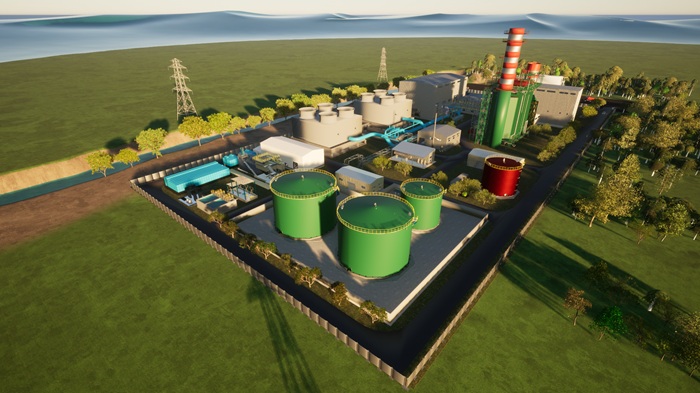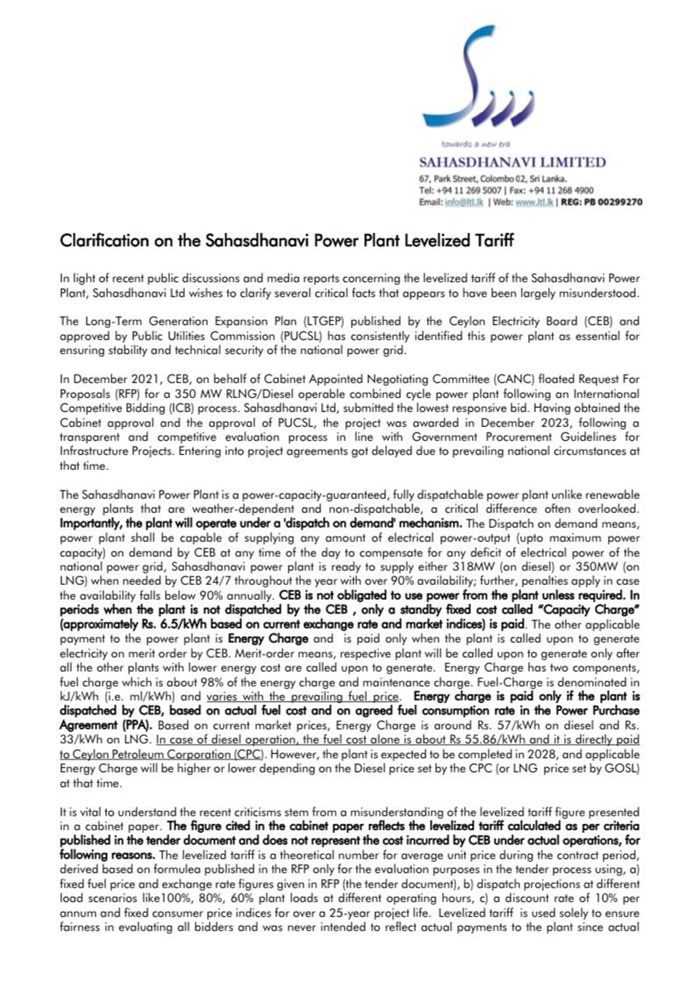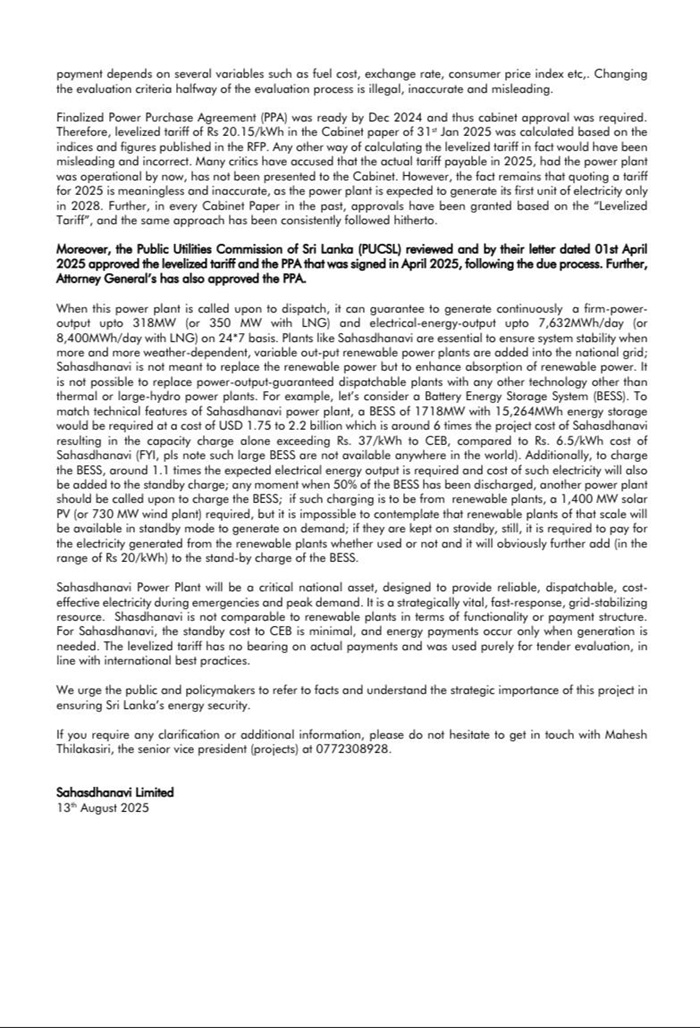
Sahasdhanavi Ltd has issued a clarification on recent concerns raised in the media about the Sahasdhanavi Power Plant, a 350 MW combined cycle power plant being developed in Kerawalapitiya, stating that the criticisms stem from a misunderstanding of the levelized tariff figure presented in a cabinet paper.
Issuing a statement, Sahasdhanavi Ltd pointed out that the figure cited in the cabinet paper reflects the levelized tariff calculated as per the criteria published in the tender document and does not represent the cost incurred by the Ceylon Electricity Board (CEB) under actual operations.
“It is so for the following reasons. The levelized tariff is a theoretical number for the average unit price during the contract period, derived based on formulas published in the RFP, only for evaluation purposes in the tender process using, a) fixed fuel price and exchange rate figures given in RFP (the tender document), b) dispatch projections at different load scenarios like100%, 80%, 60% plant loads at different operating hours, c) a discount rate of 10% per annum and fixed consumer price indices for over a 25-year project life,” it said.
The company further said that the levelized tariff is used solely to ensure fairness in evaluating all bidders and was never intended to reflect actual payments to the plant since actual payment depends on several variables, such as fuel cost, exchange rate, consumer price index, etc.
“The Finalized Power Purchase Agreement (PPA) was ready by Dec 2024 and thus, cabinet approval was required. Therefore, the levelized tariff of Rs 20.15/kWh in the Cabinet paper of 31st Jan 2025 was calculated based on the indices and figures published in the RFP. Any other way of calculating the levelized tariff, in fact, would have been misleading and incorrect. Many critics have accused that the actual tariff payable in 2025, had the power plant been operational by now, has not been presented to the Cabinet. However, the fact remains that quoting a tariff for 2025 is meaningless and inaccurate, as the power plant is expected to generate its first unit of electricity only in 2028. Further, in every Cabinet Paper in the past, approvals have been granted based on the “Levelized Tariff”, and the same approach has been consistently followed hitherto. Moreover, the Public Utilities Commission of Sri Lanka (PUCSL) reviewed and, by their letter dated 01st April 2025, approved the levelized tariff and the PPA that was signed in April 2025, following the due process. Further, the Attorney General has also approved the PPA,” it said.
Sahasdhanavi Ltd went on to note that the Sahasdhanavi Power Plant is a power-capacity-guaranteed, fully dispatchable power plant, unlike renewable energy plants that are weather-dependent and non-dispatchable, a critical difference often overlooked. The company explained that the plant will operate under a ‘dispatch on demand’ mechanism.
“The Dispatch on demand means, the power plant shall be capable of supplying any amount of electrical power output (up to maximum power capacity) on demand by CEB at any time of the day to compensate for any deficit of electrical power of the national power grid. The Sahasdhanavi power plant is ready to supply either 318MW (on diesel) or 350MW (on LNG) when needed by CEB 24/7 throughout the year, with over 90% availability; further, penalties apply in case the availability falls below 90% annually. CEB is not obligated to use power from the plant unless required. In periods when the plant is not dispatched by the CEB, only a standby fixed cost called “Capacity Charge” (approximately Rs. 6.5/kWh based on current exchange rate and market indices) is paid. The other applicable payment to the power plant is the Energy Charge, which is paid only when the plant is called upon to generate electricity on merit order by CEB. Merit-order means that the respective plant will be called upon to generate only after all the other plants with lower energy cost are called upon to generate. Energy Charge has two components: the fuel charge, which is about 98% of the energy charge and the maintenance charge. Fuel charge is denominated in kJ/kWh (i.e. ml/kWh) and varies with the prevailing fuel price. Energy charge is paid only if the plant is dispatched by CEB, based on actual fuel cost and on the agreed fuel consumption rate in the Power Purchase Agreement (PPA). Based on current market prices, Energy Charge is around Rs. 57/kWh on diesel and Rs. 33/kWh on LNG. In case of diesel operation, the fuel cost alone is about Rs 55.86/kWh, and it is directly paid to Ceylon Petroleum Corporation (CPC),” it said.
Sahasdhanavi Ltd said, however, the plant is expected to be completed in 2028, and the applicable Energy Charge will be higher or lower depending on the Diesel price set by the CPC (or LNG price set by GOSL) at that time.
Pointing out that the standby cost to CEB is minimal, and energy payments occur only when generation is needed, Sahasdhanavi Ltd said the levelized tariff has no bearing on actual payments and was used purely for tender evaluation, in line with international best practices.
Emphasizing that the Sahasdhanavi Power Plant will be a critical national asset, designed to provide reliable, dispatchable, and cost-effective electricity during emergencies and peak demand, the company urged the public and policymakers to refer to facts and understand the strategic importance of this project in ensuring Sri Lanka’s energy security. (Newswire)


